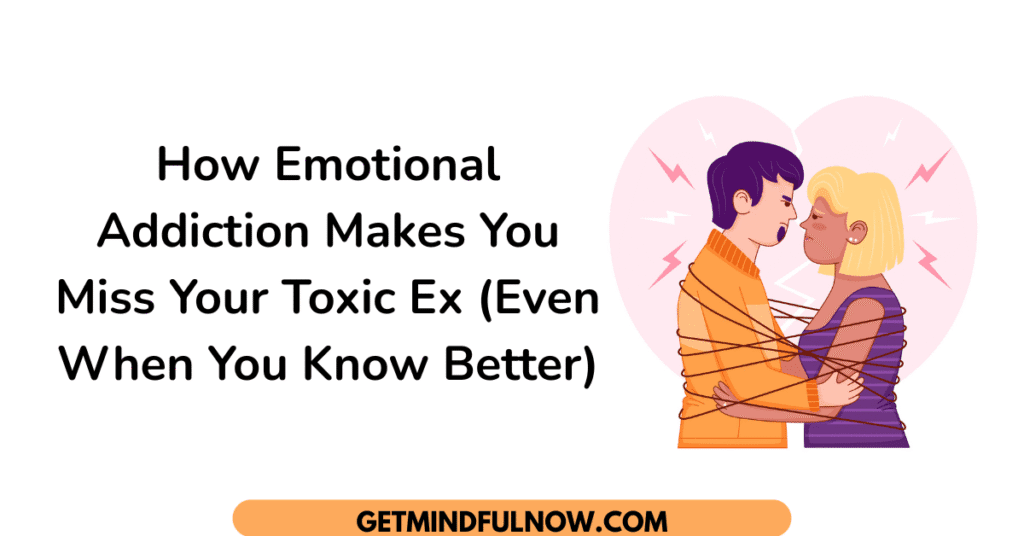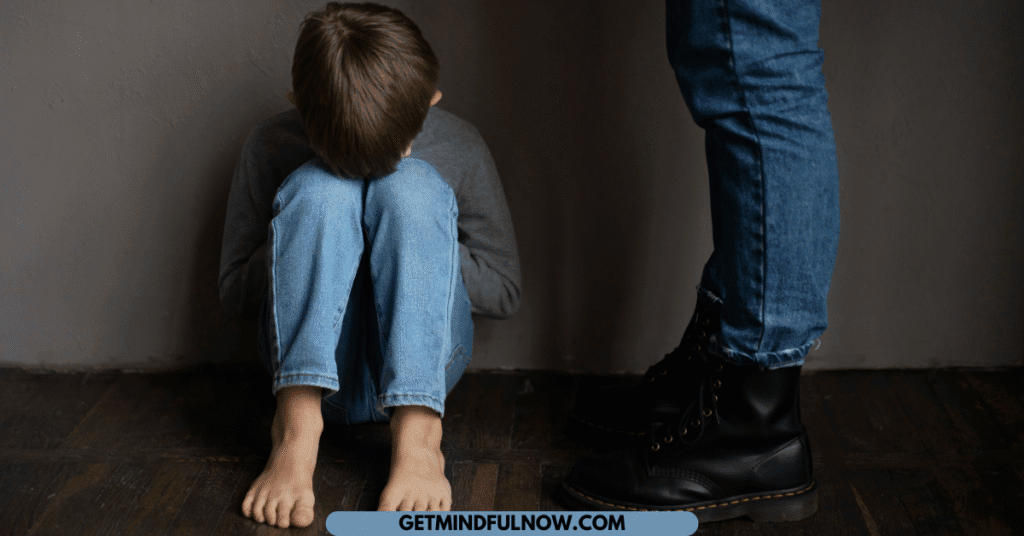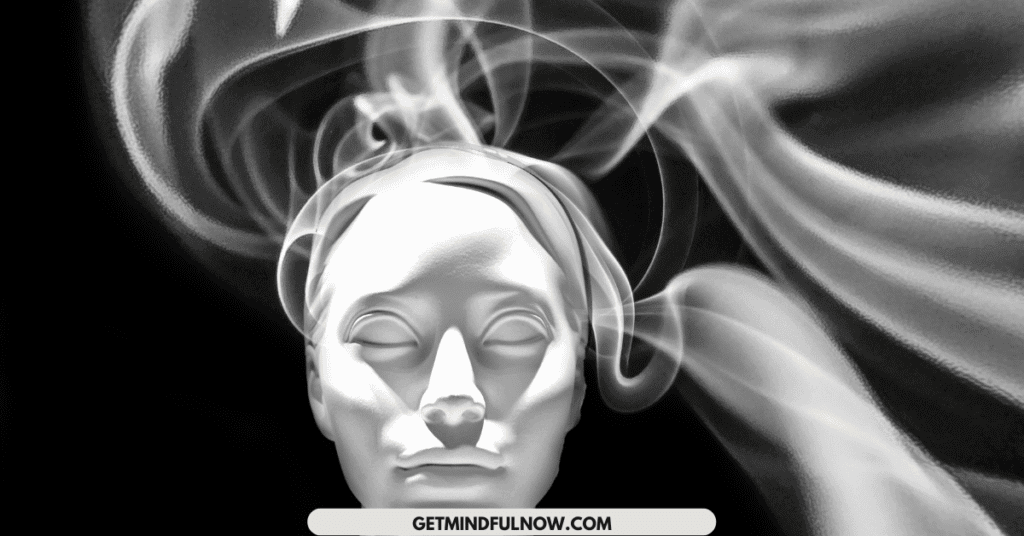It starts with little things. You try to express a need, they deflect. You bring up how hurt you feel, they say you’re too sensitive. You cry in silence because you’re tired of hearing how everything is your fault.
You’re constantly adjusting. Shrinking. Softening your tone. Trying harder, maybe if you do everything perfectly, they’ll see you. Maybe this time they’ll stop making you feel like the problem.
But they don’t. They never do.
And then someone, maybe a friend, a sibling, or a therapist, says, “Why don’t you just leave?”
You want to say, Because it’s not that simple. Not because you’re happy. Not because you’re blind.
But because something in you keeps pulling you back.
This is where we need to talk about emotional addiction.
You’re not just in a toxic relationship. You’re chemically tied to the cycle it created.
Let’s break that down, for real this time.
I know. That hits like a punch to the chest. But it’s the truth almost no one explains well. You’re not just in a bad relationship, you’re in a chemical relationship. Your body is literally dependent on the emotional patterns that relationship gives you. And until you understand what’s really going on, you’ll keep blaming your self-esteem when it’s your nervous system that’s hijacked.
So Why Don’t You “Just Leave”?
Because your brain has rehearsed the emotional chaos so many times, it’s firing on autopilot.
Every time something stressful happens, another fight, another silent treatment, another moment of walking on eggshells, your brain fires the same emotional programs. And your body, after years of absorbing that emotional chemical soup, starts expecting it like clockwork.
You’re not choosing to crave it, but your nervous system is trained to.
Here’s what’s happening in simple terms:
- Your brain gets triggered.
- It sends out chemicals (like cortisol, adrenaline, and other stress signals).
- Your body reacts, and your cells say, “Oh yes, we know this feeling. Give us more.”
It’s like emotional muscle memory.
And when you try to leave, even just imagining peace, your body panics.
Not because peace is bad. But because peace feels unfamiliar.
Imagine you’ve been drinking bitter coffee every day for ten years. Suddenly, someone hands you clean, sweet water. Your body will reject it. Not because the water is wrong, but because the coffee became your normal.
That’s what emotional addiction feels like.
You crave the argument. You brace for the insult. You search for signs they’ll blow up. Not because you want to suffer, but because your brain-body loop has practiced that story over and over.
Breaking that cycle doesn’t start with leaving. It starts with understanding what’s pulling you back.
What Emotional Addiction Looks Like in Real Life
You cry yourself to sleep and swear you’re done.
You picture packing your bags. You even Google divorce lawyers.
But the next morning, you make them breakfast. You tiptoe around their mood. You say “maybe it’s just a phase.”
You remember you’ve got kids. And maybe no support system. You think, How will I manage this alone? You convince yourself to stay “for now.” But it’s not just the circumstances keeping you stuck, it’s your body’s addiction to the emotional rollercoaster.
Why? Because your body is doing everything it can to get its next fix of what it’s used to.
You don’t want the abuse. But you want the familiarity. That’s how addiction works.
- You know they won’t change.
- You know you deserve better.
- But your body only knows how to survive this version of you.
And that survival mode has been running on a loop through your brain’s stress response system, your hypothalamus-pituitary-adrenal (HPA) axis(Don’t worry, I will explain HPA in some other blog!). It’s been pumping out stress hormones so consistently, your entire being thinks this level of tension is “normal.”
So when peace shows up, even just the idea of it, your nervous system rejects it. It’s not what your brain-body chemistry is rehearsed in.
It’s like trying to stop drinking coffee and then walking into Starbucks every morning out of habit.
When Misery Becomes Your Identity
the deeper cut: it’s not just your body that’s addicted to the emotional cycle. Your identity has fused with it. Slowly. Quietly. Over time.
You’ve spent years being the one who “keeps the peace,” the one who sacrifices for the kids, the one who says “I’m fine” when you’re anything but. You became the fixer. The emotional shock absorber. The one who swallows your truth because rocking the boat never made anything better.
You tell yourself, “This is just what I have to do.”
You make excuses for them. You explain away their behavior. You tell others, “They’re not always like this,” even though you cry when no one’s looking.
That version of you, built in survival, soaked in self-neglect, has become familiar. Predictable. Safe, even.
And now the idea of leaving doesn’t just feel like letting go of a marriage, it feels like letting go of who you are.
That’s not love. That’s a loss of self, hidden behind habit.
Because when suffering becomes your normal, peace feels like a stranger. And strangers don’t feel safe.
I know survival kept you alive, yes. But it’s not meant to be your identity. And you’re allowed to outgrow it.
You don’t have to earn your right to live differently. You just have to stop identifying with the version of you that was built for pain.
And survival is not the same as living.
The Science You Need to Know
Every time you feel intense fear, guilt, or shame, your brain releases a surge of neuropeptides, chemical messengers that create emotions in the body.
Your cells absorb these chemicals through receptors.
The more you feel these emotions, the more receptors your cells build to receive them. It’s like your body is saying, “Oh, this again? Cool, let’s make this our baseline.”
Now, when you try to stop feeling those emotions, by leaving, setting a boundary, or imagining a life of peace, your body revolts.
Your cells send messages through the peripheral nervous system to your spinal cord and brain, screaming, “Give me what I know! This calm doesn’t feel safe!”
That’s why change feels like anxiety. Not because it’s wrong, but because your body hasn’t been taught how to live without chaos.
You’re not broken. You’re chemically conditioned.
And just like someone detoxing from drugs, you need a process to rewire your emotional baseline.
Why You Still Hope They’ll Change
Nobody tells you that Part of the addiction is hoping. Hoping they’ll apologize. Hoping the next version of them will match the fantasy you had at the start.
Because your body has paired “hope” with the emotional rollercoaster.
It feels more comfortable to hope and hurt than to walk away and heal.
You keep giving chances not just because you want love, but because your cells still believe this pain is love.

Before You Begin: My Personal Journey With Emotional Addiction
I didn’t understand any of this until I lived it, until I went through it with my own mother.
She wasn’t just difficult. She was emotionally unavailable, dismissive, and manipulative. I kept trying to earn her love. I made excuses. I clung to hope. I stayed longer than I should have, not because it was good, but because it was familiar.
Every time I thought she’d changed, she’d put a dagger back in my chest, emotionally, verbally, energetically. And still… I returned.
It took me years of blood, tears, sweat, and science to realize: I wasn’t just loving her. I was addicted to the cycle. My body didn’t know how to exist without the ache, the guilt, the pursuit.
Learning this science didn’t come easy, but it saved my life. I now live in a quiet, small world, peaceful but unfamiliar, and I still do the work, every day, to not relapse. Because this addiction work? It’s real. It’s not just a metaphor. It’s chemistry.
Now, here’s what helped me begin to break the cycle, and what can help you too.
A 7-Step Process to Start Breaking the Cycle
This isn’t a motivational checklist. It’s a practical, neurological approach to interrupt the addiction, and this is why it works:
Your brain is most open to rewiring when it’s in the alpha/theta state, which happens first thing in the morning before your conscious, analytical mind fully kicks in. In that window, your frontal lobe, the part responsible for intentional change, planning, and imagination, is online and ready to reprogram the rest of your mind and body.
I did this work alone, not because it’s noble or ideal, but because I had no choice. And to be honest, I wouldn’t recommend it. Most people shouldn’t walk this path alone. It took me years, breakdowns, and brutal inner work just to build a peaceful life that still feels unfamiliar. If I had support, if I had someone trained to guide me, I would have taken that path in a heartbeat.
So don’t think you have to be alone in this. You don’t have to white-knuckle your healing. Work with someone. Work with me. Because emotional addiction isn’t something you just “think” your way out of, it’s something you retrain your body through, with help.
That said, if you’re still in the trenches, know this: if you’ve been willful in surviving pain, you can be just as willful in building peace.
And throughout your day, you need to practice metacognition, the ability to pause and observe what you’re thinking most. Write it down. Then take those most familiar thoughts and bring them into your meditation the next morning. That’s where you replace the wiring.
And when you ask your frontal lobe intentional questions like, “Who do I want to be in this same situation?”, you begin activating future-based neural pathways. Your brain doesn’t know the difference between a real memory and a vividly imagined future.
That’s why people panic in virtual reality when they’re hanging from a fake cliff, because the brain triggers real physical symptoms.
Use that same principle to feel a future where you’re calm, unhooked, and free. That’s how your body starts trusting the unfamiliar.
Now let’s walk through the steps:
1. Get Still Every Morning Before the World Wakes Up
Right when you wake up, your brain is in alpha/theta, the sweet spot where your subconscious is open. Use this time to get quiet. Don’t grab your phone. Sit with yourself. This is where the reprogramming begins.
2. Acknowledge the Emotion Your Body Feeds On
Is it fear? Guilt? Desperation? Disgust?, Shame? Identify the emotion that your nervous system runs on every day. Don’t shame it. Just name it.
3. Feel It, But Don’t Let It Take Over
Let it come up. Don’t suppress it. But also, don’t indulge it. Feel it as a memory your body is replaying, not as your identity.
4. Introduce a New Emotional State-On Purpose
Now ask: what do I want to feel instead? Relief? Peace? Strength? Gratitude? Bring up that emotion. Even if it feels fake. Even if it’s tiny. This is how you teach your body to shift.
5. Mentally Rehearse a New Response
Picture the same scenario, but with a new version of you. One that doesn’t react. One that doesn’t fold. See yourself setting the boundary. Walking away. Feeling calm.
6. Speak a Command Out Loud
This rewires your identity. Say: “I no longer live in emotional survival. I am safe in who I’m becoming.” Do it even if your voice shakes.
7. Repeat It Every Day Until It Feels Normal
This is the part everyone skips. But repetition is the language of the body. You have to teach it what peace feels like. Every. Single. Day.
Why Consistency Is Everything Before You Heal for Good
If you take nothing else from this, take this:
Consistency is the key to rewiring emotional addiction.
Your neurons follow the rule: “What fires together, wires together.” But here’s what people forget: what doesn’t fire together eventually dies off. That means the emotional habits you stop feeding will begin to prune away.
And the ones you repeat, calm, boundaries, stillness, will build stronger synaptic connections.
Think about medication. Even in clinical drug trials, patients need to take a pill for at least 6–8 weeks before it makes real chemical changes in the body. This work is no different.
You’ve spent years training your body to live in emotional survival. It makes sense that unlearning it will take time too.
But the return is exponential.
Stay in the practice. Keep doing the work, even when it feels small. Especially when it feels small.
Because eventually, your body will stop craving pain, your nervous system will stop choosing war. and your life will begin to match the safety you’ve practiced inside.
Final Truth: It’s Not Just the Marriage You’re Leaving
It’s not just the relationship you’re letting go of.
It’s the version of you that fought so hard to keep it alive.
The version of you that overextended, over-functioned, over-apologized, and over-adapted, because you were afraid that choosing yourself meant you’d end up alone.
It’s the version of you who became an expert at reading moods, fixing tension, patching wounds that weren’t yours to begin with.
It’s the woman who became so good at surviving, she forgot she was allowed to do anything else.
Walking away from that marriage isn’t just about closing a chapter. It’s about breaking up with a version of you that only knew how to live in fight-or-flight. A version of you that called pain home. A version of you that got so used to being unseen, unheard, and unheld, that she stopped asking for more.
And that’s the version that’s dying now.
You’re not just walking out of a marriage. You’re walking into a new nervous system. A new baseline. A new identity built on self-trust and internal safety.
The part of you that believed love required suffering? She’s not coming with you.
You’re not leaving her behind with shame. You’re leaving her behind with honor.
Because she kept you alive.
But you? You’re finally ready to live.
And she’s ready to come home.
Subscribe for More Real Talk Like This
If this cracked something open in you… if you’re done with empty advice and want science-backed tools that speak to your actual biology, not just your mindset, subscribe to my newsletter and follow on Threads.
I write for the women who’ve done the talk therapy, read the books, but still feel stuck in their bodies.
Let’s get unstuck. Together.








